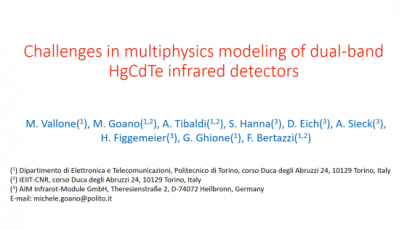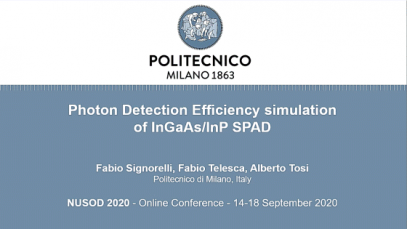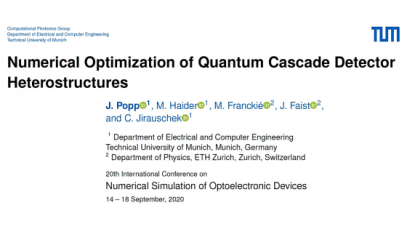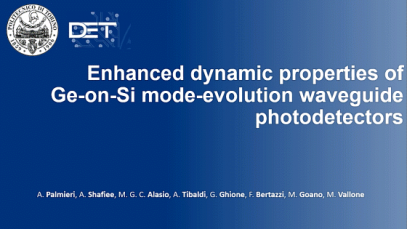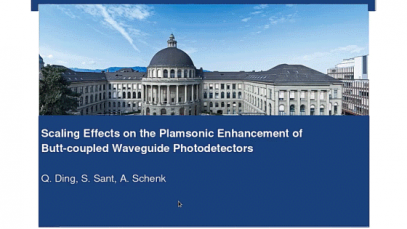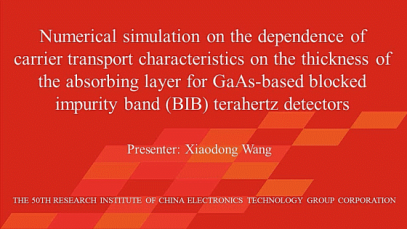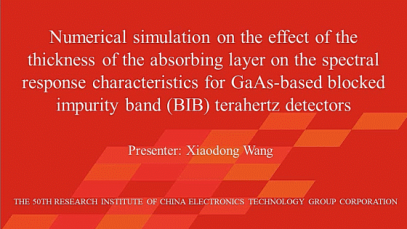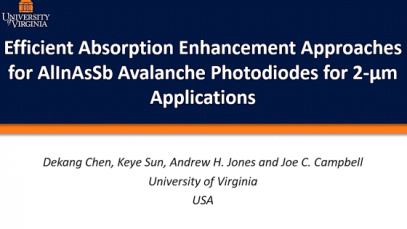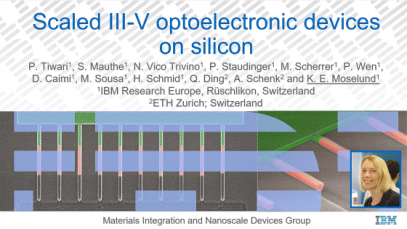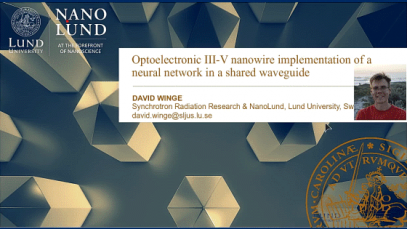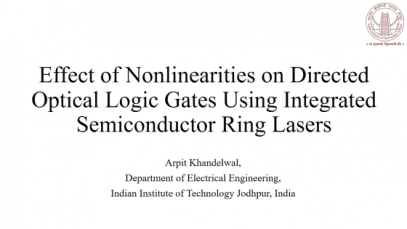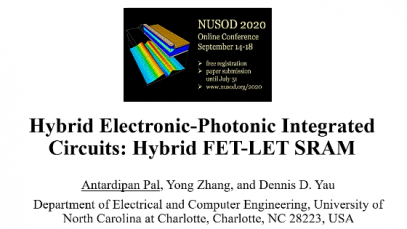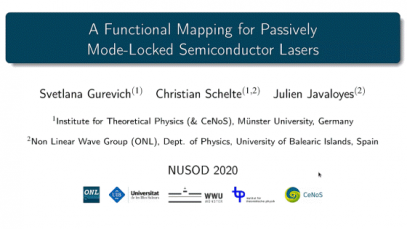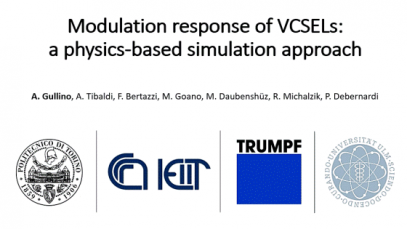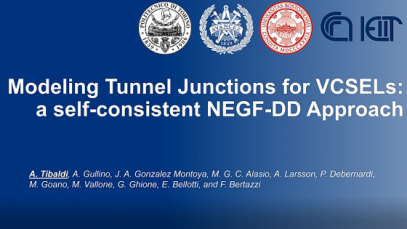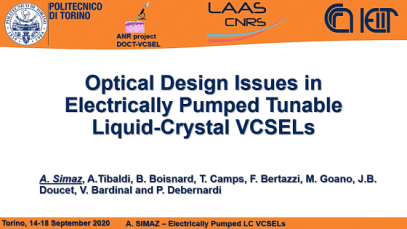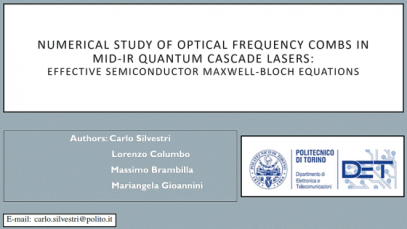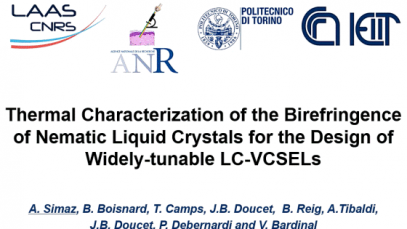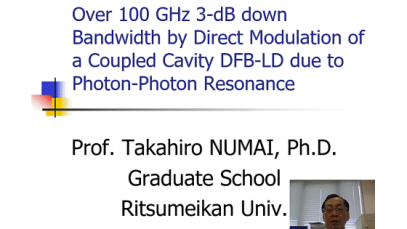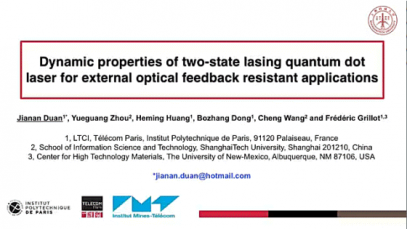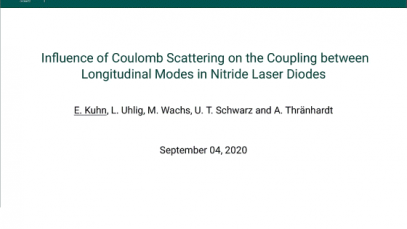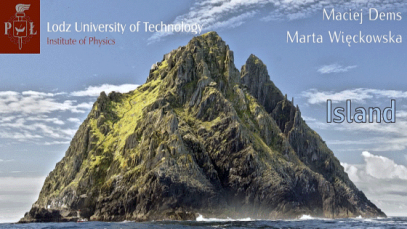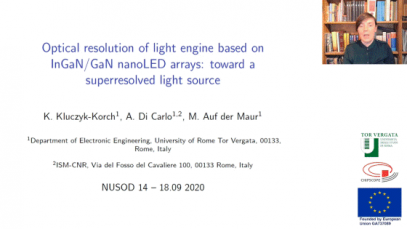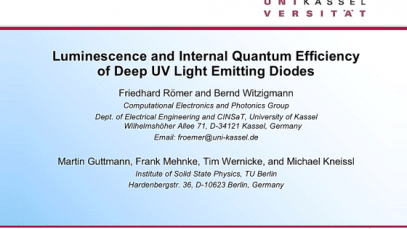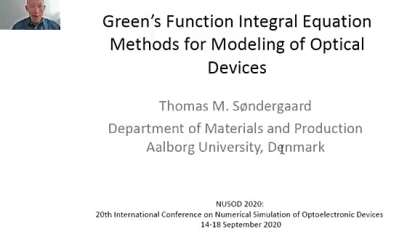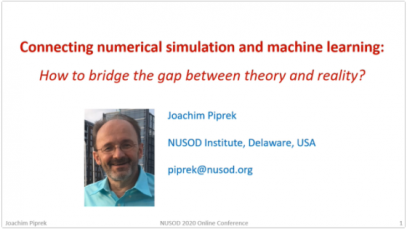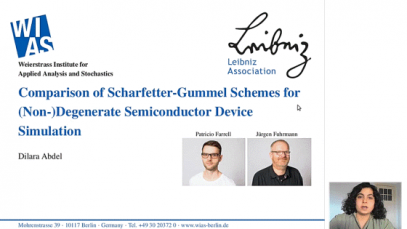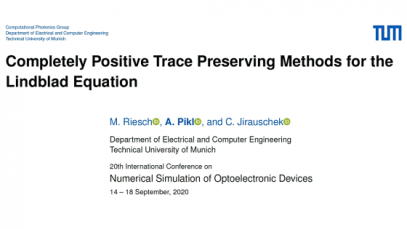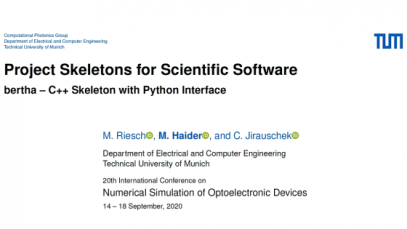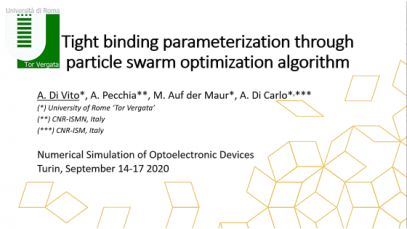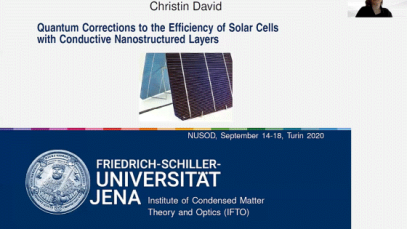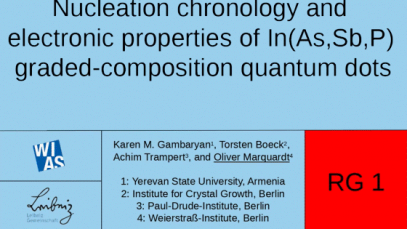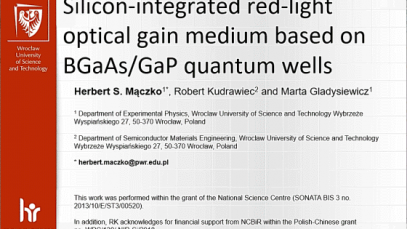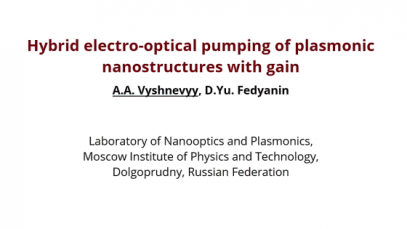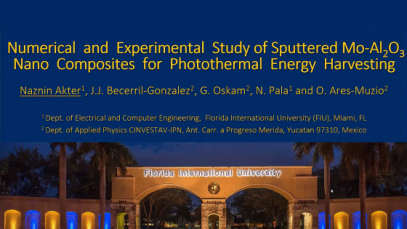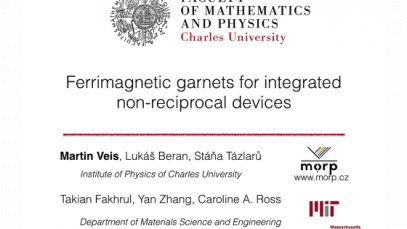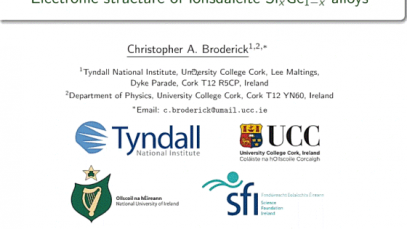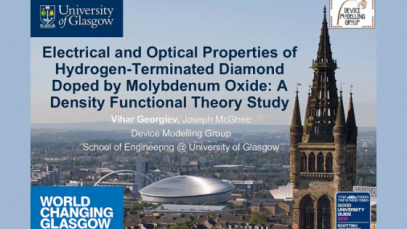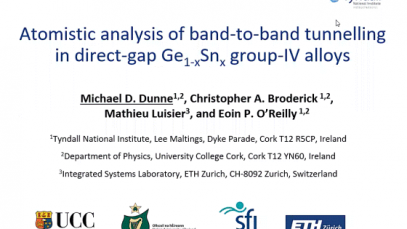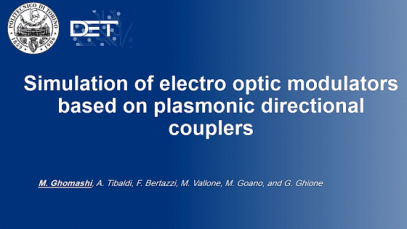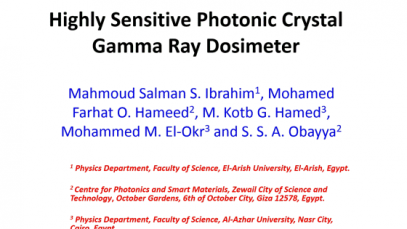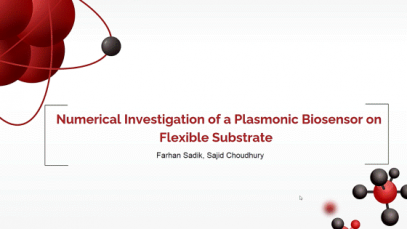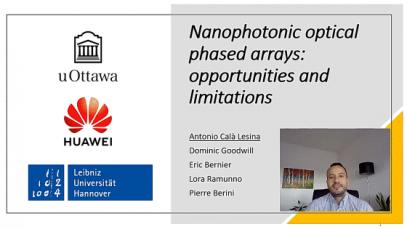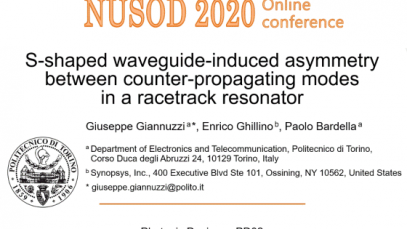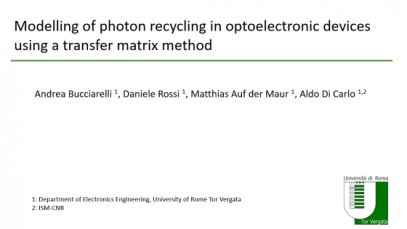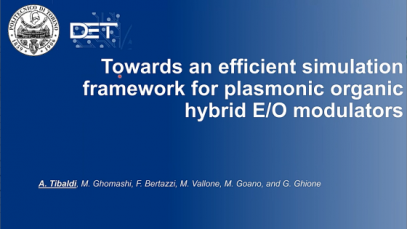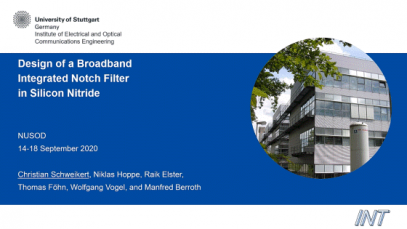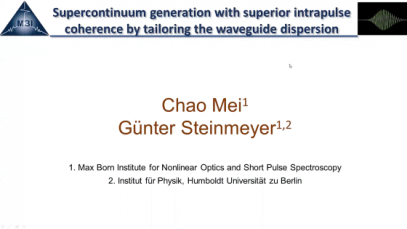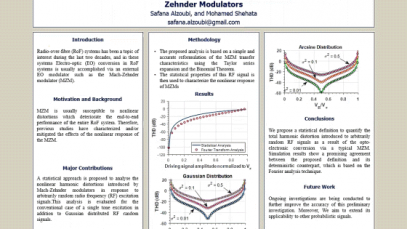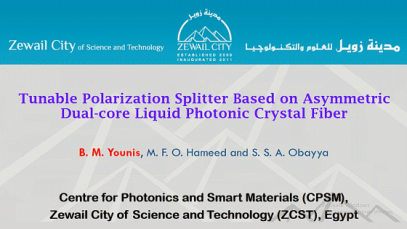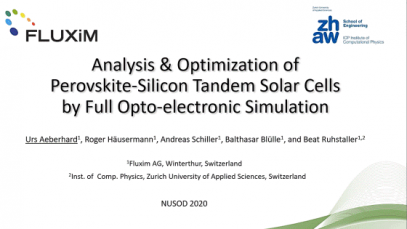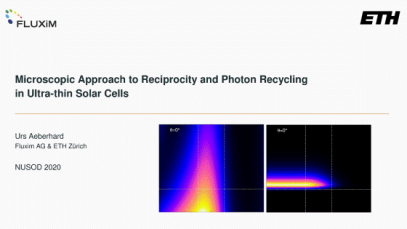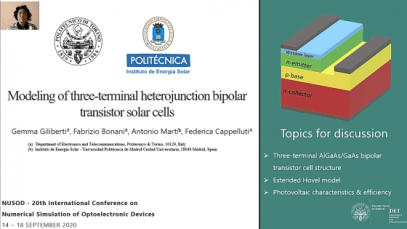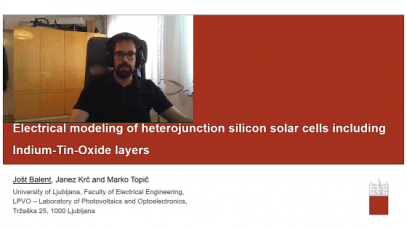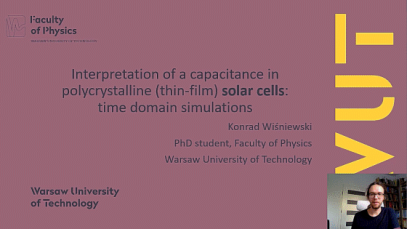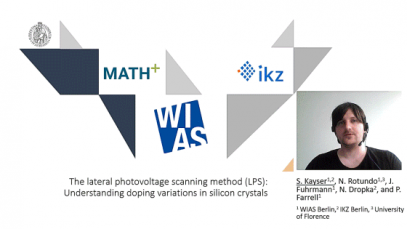Presentations
D01–Challenges in multiphysics modeling of dual-band HgCdTe infrared detectors
We present three-dimensional simulations of HgCdTe-based focal plane arrays (FPAs) with two-color and dual-band sequential infrared pixels having realistic truncated-pyramid shape taking into account the presence of compositionally-graded transition layers. Simulations emphasize the importance of a full-wave approach to the electromagnetic problem, and the evaluations of the optical and diffusive contribution to inter-pixel crosstalk indicate […]
D02–Photon Detection Efficiency simulation of InGaAs/InP SPAD
We present a comprehensive simulation flow for the estimation of photon detection efficiency as a function of wavelength in InGaAs/InP single-photon avalanche diodes (SPADs) at low temperature. We introduce a joint modelling of electrical and optical properties for SPAD detectors. We also highlight how accurately different parameters have to be calibrated in order to achieve […]
D03–Numerical Optimization of Quantum Cascade Detector Heterostructures
We demonstrate a Bayesian optimization framework for quantum cascade (QC) devices in the mid-infrared (mid-IR) and terahertz (THz) regime. The optimization algorithm is based on Gaussian process regression (GPR) and the devices are evaluated using a perturbed rate equation approach based on scattering rates calculated self-consistently by Fermi’s golden rule or alternatively extracted from an […]
D04– Simulation of an Integrated UTC-Photodiode with a High-Speed TIA for 5G mm-Wave Generation
This work introduces a subsystem level cosimulation for generation, boosting and transmission of millimeter wave signals for 5G applications. The simulation processes to model the full equivalent circuit of uni-traveling carrier photodiodes based on reflection coefficient measurements are analyzed. The optoelectronic lumped equivalent is co-integrated with a transimpedance amplifier design synthesized by high speed transistors. […]
D05–Enhanced dynamic properties of Ge-on-Si mode-evolution waveguide photodetectors
This work discusses coupled three-dimensional electromagnetic and electrical simulations of a Ge-on-Si waveguide photodetector where light is fed through a lateral waveguide. The numerical results show that this coupling solution leads to more uniform photon and carrier distributions along the Ge absorber compared to a conventional butt-coupled detector, allowing a broader electrooptical bandwidth for high […]
D06–Scaling Effects on the Plasmonic Enhancement of Butt-Coupled Waveguide Photodetectors
We employed 3D opto-electrical simulations to study the scaling effects of a plasmonic structure on the optical performance of butt-coupled waveguide photodetectors by placing an Ag stripe on top of the intrinsic region. It is found that cut-offs which are limited by carrier drift in the high-field region of the non-plasmonic device improve with longer […]
D07–Numerical simulation on the dependence of carrier transport characteristics on the thickness of the absorbing layer for GaAs-based blocked impurity band (BIB) terahertz detectors
The dependence of carrier transport characteristics on the thickness of the absorbing layer for Gallium Arsenide (GaAs) blocked-impurity-band (BIB) terahertz detector has been investigated in detail. It is found that responsivity linearly increases with the increased thickness of absorbing layer first, and after achieving a peak value, and then starts to dropping slowly.
D08–Numerical simulation on the effect of the thickness of the absorbing layer on the spectral response characteristics for GaAs-based blocked impurity band (BIB) terahertz detectors
The effect of the thickness of the absorbing layer on the spectral response characteristics for Gallium Arsenide (GaAs) blocked-impurity-band (BIB) terahertz detector has been investigated in detail. It is found that Response bandwidth (BWR) is approximately a linear function of hAbs, and the relationship between the Response bandwidth (BWR) and hAbs has been given in […]
D09–Efficient Absorption Enhancement Approaches for AlInAsSb Avalanche Photodiodes for 2-μm Applications
We describe two photon-trapping structures to enhance the quantum efficiency of AlInAsSb APDs for 2-μm detection. Finite-difference time-domain (FDTD) simulations show the absorption can be enhanced by more than 100 % with a triangular lattice photonic crystal, and nearly 400 % by applying a metal grating, for normal incidence at 2 µm.
IS01–Scaled III-V optoelectronic devices on silicon
In the present talk we discuss the development of the epitaxial technique Template-Assisted Selective Epitaxy (TASE) and its application for the monolithic integration of scaled III-V active photonic devices on silicon. A unique advantage of TASE for silicon photonics applications is that it enables a truly local integration of III-V material at precisely defined positions, […]
IS02–Shape Optimized Photonic Integrated Circuit for Optical Computing Applications
Shape optimization techniques were quite recently applied to photonic components but to the best of our knowledge, no application to optical computing has been reported yet. Here, we present the design of a photonic integrated circuit, composed of shape optimized passive components, performing a matrix-vector product. A ≈ 2000 times gain on the overall footprint […]
IS03–Simulation of cascaded polarization-coupled systems of broad-area semiconductor lasers
We present a brightness- and power-scalable polarization beam combining scheme for high-power, broad-area semiconductor lasers. To achieve the beam combining, we employ Lyot-filtered optical reinjection from an external cavity, which forces lasing of the individual diodes on interleaved frequency combs with overlapping envelopes and enables a high optical coupling efficiency. We demonstrate how repeatedly introduced […]
IS04–Optoelectronic III-V nanowire implementation of a neural network in a shared waveguide
Neural node components consisting of III-V nanowire devices are introduced. This allows for the construction of a small footprint specialized neural network. A broadcasting strategy is developed which removes the need for inter-node wiring. As a model system, an insect brain navigational circuit is chosen and successfully emulated using the introduced nodes and network architecture. […]
IS05–Effect of Nonlinearities on Directed Optical Logic Gates Using Integrated Semiconductor Ring Lasers
Nonlinearities in the semiconductor ring laser (SRL) are incorporated in the analysis of directed optical logic gates and their effects on the output are studied. The paper discusses the effects of gain medium linewidth, internal quantum efficiency and self and cross gain saturation on the output of directed optical NOT gate implemented using SRLs.
IS06–Hybrid Electronic-Photonic Integrated Circuits: Hybrid FET-LET SRAM
High speed, low power, low leakage, and low noise circuits are extremely essential for modern VLSI chips. Since on-chip cache memories consume appreciable amount of the total chip area and energy, high performance and low power Static Random-Access Memories (SRAMs) are needed for high performance and low power electronic systems. A hybrid FET-LET 6T SRAM, […]
LD01–Third Order Dispersion in Optical Time Delayed Systems: The case of Mode-Locked Vertical External-Cavity Surface-Emitting Lasers
Time-delayed dynamical systems materialize in situations where distant, point-wise, nonlinear nodes exchange information that propagates at a finite speed. However, they are considered devoid of dispersive effects, which are known to play a leading role in pattern formation and wave dynamics. We show how dispersion may appear naturally in delayed systems and we exemplify our […]
LD02–A Functional Mapping for Passively Mode-Locked Semiconductor Lasers
We present a modern approach for the analysis of passively mode-locked semiconductor lasers that allows for efficient parameter sweeps and time jitter analysis. It permits accessing the ultra-low repetition rate regime where pulses become localized states. The analysis including slow (e.g. thermal) processes or transverse, diffractive dynamics becomes feasible. Our method bridges the divide between […]
LD03–Modulation response of VCSELs: a physics-based simulation approach
A preliminary study of the dynamic behaviour of a GaAs/AlGaAs 850 nm VCSEL is presented, with the focus on the small-signal analysis and in particular on the optical amplitude modulation response. Simulations are performed with our in-house quantum-corrected one-dimensional drift-diffusion code D1ANA, updated to perform the AC analysis. The -3 dB cutoff frequency of the […]
LD04–Modeling Tunnel Junctions for VCSELs: A Self-Consistent NEGF-DD Approach
In this work we investigate carrier transport in tunnel junctions for vertical-cavity surface-emitting lasers by a novel self-consistent simulation framework for semiconductor quantum devices. Based on a Poisson-drift-diffusion foundation, in this approach quantum features are described through a nonequilibrium Green’s function formalism. The simulator is validated through a comparison with experimental results.
LD05–Optical Design Issues in Electrically Pumped Tunable Liquid-Crystal VCSELs
In this work we investigate a tunable 850nm laser based on a hybrid combination of a liquid crystal micro-cell and a half GaAs VCSEL. The target application is optical coherence tomography. The inherent tolerances of the hybrid technology, the presence of metals in the cavity and the need for a pure extraordinary mode lasing make […]
LD06–Numerical Study of Optical Frequency Combs in mid-IR Quantum Cascade Lasers: Effective Semiconductor Maxwell-Bloch Equations
In this paper a theoretical model based on Effective Semiconductor Maxwell-Bloch Equations (ESMBEs) is proposed for the description of the dynamics of a multi-mode mid-Infrared (mid-IR) Quantum Cascade Laser (QCL) in Fabry Perot (FP) configuration, in order to investigate the spontaneous generation of frequency combs in this device. In agreement with recent experimental results our […]
LD07–Thermal Characterization of the Birefringence of Nematic Liquid Crystals for the Design of Widely-tunable LC-VCSELs
In this work, the thermo-optical properties of nematic liquid crystals are investigated through localized reflectance spectra measurements performed on a tunable LC-filter. The final aim is to insert such LC in the cavity of a tunable VCSEL device, in which local self-heating due to optical or electrical pumping must be taken into account. We demonstrate […]
LD08–Jitter Reduction of Mode-Locked Hybrid Silicon Laser With Intra Cavity Filter
We study the influence of the intra-cavity ring on dynamics, phase noise and timing jitter of a long-ring-cavity colliding pulse mode-locked laser using a delay differential equation (DDE) model. The results of dynamic show that the intra-cavity filter can suppress harmonics of 2 GHz cavity. We also find a reduction of phase noise and timing […]
LD09–Over 100 GHz 3-dB down Bandwidth by Direct Modulation of a Coupled Cavity DFB-LD due to Photon-Photon Resonance
This paper reports on 3-dB down bandwidth of 110.6 GHz by direct modulation of a coupled cavity DFB-LD with phase-shifted/uniform gratings due to photon-photon resonance when the injected current is 3.5 times the threshold current.
LD10–Dynamic properties of two-state lasing quantum dot laser for external optical feedback resistant applications
This work investigates the dynamics of two-state quantum dot lasers through semi-analytically solving a set of rate equations. Simulations reveal that the occurrence of excited state lasing reduces the damping factor of the laser while increases the linewidth enhancement factor associated to the ground state transition. These results are in good agreement with the experimental […]
LD11–Influence of Coulomb Scattering on the Coupling between Longitudinal Modes in Nitride Laser Diodes
Due to their small separation of longitudinal modes, Fabry-Perot type laser diodes show rich mode competition effects. For example streak camera measurements show cyclic mode hopping, where the currently active longitudinal mode changes from lower to higher wavelengths. This effect can be explained by beating vibrations of the carrier densities in the quantum wells and […]
LD12–Modeling Impact of Oxide Island on the Lasing of ARROW-VCSEL
We analyze the impact of a low-refractive antiresonant oxide island buried in a top VCSEL mirror on the lasing conditions of lateral modes of different orders. By performing comprehensive thermal, electrical, and optical numerical analysis of the VCSEL device, we show the impact of the size and location of the oxide island on the current […]
LED01–Optical resolution of light engine based on InGaN/GaN nanoLED arrays: toward a superresolved light source
We present the optical simulations of a novel illumination source based on nanoLED arrays for the possible application in superresolved microscopy. We are simulating the images of various gold nanoparticle arrangements collected by the proposed nanoillumination microscope. The images are then analysed in order to understand the capabilities and limitations of the microscope.
LED02–Luminescence and Internal Quantum Efficiency of Deep UV Light Emitting Diodes
Deep ultraviolet (DUV) light emitting diodes (LED) made of Aluminium Gallium Nitride (AlGaN) are increasingly considered as light sources for medical as well as material processing applications. Recent research on AlGaN DUV LEDs focuses on the enhancement of the efficiency. The efficiency of AlGaN LEDs is limited by a low hole injection efficiency and TM-polarized […]
LED03–Modeling of multi-electrode tapered quantum-dot superluminescent diode
We introduce a rate equation based numerical model suitable for the description of the wide spectral asymmetry experimentally observed at the two facets of multi-electrode tapered superluminescent diode based on Quantum Dot material. Numerical simulations carried out with this model were able to quantitatively reproduce the behavior of a two-section SLD and explain the reported […]
MM01–Green’s function integral equation methods for modeling of optical devices
Green’s function integral equation methods are presented that can be applied for modeling of optical devices in cases where the problem can be formulated as a scattering problem. The methods are applied to study in three dimensions the effect of a cylindrical micro-lens on radiation emitted from a THz photoconductive antenna, and for studying the […]
MM02–Connecting numerical simulation and machine learning: How to bridge the gap between theory and reality?
Machine learning and numerical simulation represent opposite approaches to computational analysis of the real world, inductive vs. deductive. However, both methods suffer from various uncertainties and even their combination often fails to link theory and reality. This paper presents a critical review of such connections and proposes improvement options for optoelectronic devices.
MM03–Comparison of Scharfetter-Gummel Schemes for (Non-)Degenerate Semiconductor Device Simulation
We consider Voronoi finite volume schemes for the discretization of the van Roosbroeck system and pay particular attention to the choice of flux approximations. The classical Scharfetter-Gummel scheme yields a thermodynamically consistent numerical flux, but cannot be used for general charge carrier statistics.We compare and analyze aspects of two state-of-the-art modified Scharfetter-Gummel schemes to simulate […]
MM04–Completely Positive Trace Preserving Methods for the Lindblad Equation
The Lindblad master equation is a valuable tool in quantum mechanics, which describes the dynamics of open systems. In the scope of our research, it is combined with the one-dimensional Maxwell’s equations to form the generalized Maxwell-Bloch equations. Since analytical solutions are not available in the general case, numerical methods have to be employed to […]
MM05–Project Skeletons for Scientific Software
Although research relies heavily on software packages such as mathematical libraries or data analysis tools, efforts to provide high-quality scientific software are hardly rewarded. As a possible way out of this dilemma, project skeletons can be employed to accelerate software development while ensuring code quality. In this work, we review existing project skeletons and present […]
MM06–Tight binding parameterization through particle swarm optimization algorithm
The tight binding (TB) approach represents a good trade-off between accuracy and computational burden. For this reason, it is widely used for device simulations. However, a proper description of a physical system by means of TB requires an accurate parameterization of the Hamiltonian matrix elements (HME), that is usually done by fitting over suitable properties […]
N01–Quantum corrections to the efficiency of solar cells with conductive nanostructured layers
It was shown in many experiments that the incorporation of metallic nanostructures into photovoltaic devices results in the enhancement of solar cell efficiency. Most simulations of such devices are based on classical electrodynamics and neglect quantum effects arising from nanosized metallic structures. Here, we look at nonlocal electron-electron interactions, Lorentz friction and strong coupling of […]
N02–Nucleation chronology and electronic properties of In(As,Sb,P) graded-composition quantum dots
We have studied nucleation process and electronic properties of graded-composition quantum dots(GCQDs) grown from In-As-Sb-P in the liquid phase for application in mid-infrared devices like photoresistors or photoconductive cells. The GCQD ensemble exhibits diameters of 10 – 120 nm and heights of 2 – 20 nm. Compositional grading is a typical feature of quantum dots […]
N03–A Bi quantum film potential as an inverse problem
Experiments generally only offer access to certain output parameters or spectra. When performing device simulations, we often assume that agreement of theoretical and experimental output means that the model describes the device well. However, this conclusion is by no means mandatory. Here, we show an example of a Bi quantum film where measurements show equidistant […]
N04–Silicon-Integrated Red-Light Optical Gain Medium Based on BGaAs/GaP Quantum Wells
In this study we present BGaAs/GaP quantum well (QW) structures integrated with GaP/Si virtual substrate as a promising structure for applications requiring red-light optical gain media. Gain spectra are computed based on an 8-band k · p model with an envelope function approximation and Fermi’s Golden Rule. An emission of red light of wavelengths from […]
N05–Hybrid Electro-Optical Pumping of Plasmonic Nanostructures with Gain
We propose to pump active plasmonic devices, such as plasmonic amplifiers, lossless plasmonic waveguides and nanolasers, simultaneously electrically and optically (hybrid pumping). We show that such a pumping method results not only in a higher modal gain but also in an improved control over the spatial profile of optical gain in the device, which allows […]
N06–Hybrid Electro-Optical Pumping of Plasmonic Nanostructures with Gain
We report on the numerical and experimental study of the optical spectra of Mo-Al2O3 nanocomposites that were grown using sequential DC and RF sputtering. The measured spectra were compared with the ones calculated using FDTD simulations to analyze the prediction accuracy of the approach.
NM01–Ferrimagnetic garnets for integrated non-reciprocal devices
Ferrimagnetic garnets are promising materials for applications in integrated non-reciprocal devices due to their low optical absorption and relatively large magneto-optical response at telecommunication wavelengths. However, their implementation into phonotic chips is rather difficult due to large lattice parameters and thermal expansion mismatch with common photonic substrates. In this talk, we present our latest progress […]
NM02–Electronic structure of lonsdaleite SiGe alloys
Conventional diamond-structured silicon (Si) and germanium (Ge) possess indirect fundamental band gaps, limiting their potential for applications in light-emitting devices. However, SixGe1-x alloys grown in the lonsdaleite (“hexagonal diamond”) phase have recently emerged as a promising direct gap, Si-compatible material system, with experimental measurements demonstrating strong room temperature photoluminescence. When grown in the lonsdaleite phase, […]
NM03–Electronic and Optical Properties of Hydrogen-Terminated Diamond Doped by Molybdenum Oxide: A Density Functional Theory Study
In this work we investigate the surface transfer doping process induced between a hydrogen-terminated (100) diamond and a metal oxide MoO3, using the Density Functional Theory (DFT) method. Using DFT, we have calculated the electronic and optical properties of the hydrogen-terminated diamond and established a link between the underlying electronic structure and the charge transfer […]
NM04–Atomistic analysis of band-to-band tunnelling in direct-gap GeSn group-IV alloys
The emergence of a direct band gap in Ge1-xSnx alloys has stimulated interest in developing Ge1-xSnx alloys and nanostructures for applications in Si-compatible electronic and photonic devices. The direct band gap of Ge1-xSnx, combined with the strong band gap reduction associated with Sn incorporation, makes Ge1-xSnx a promising material system for the development of Si-compatible […]
NM05–Simulation of electro optic modulators based on plasmonic directional couplers
In this paper, a new concept and geometry are proposed for plasmonic modulators, whose operation is based on the coupling between two plasmonic slots. An electro-optic polymer is exploited as an active material, and the device can be implemented within a Silicon Photonics platform. The device operates at 1550nm wavelength, typical of data center or […]
NM09–A fiber optic probe for thermal therapy
We demonstrate a novel fiber optic device for controlled generation of photothermal effects. The fiber probe is pumped by a laser diode and incorporates polymer composites allowing to generate highly localized heat and obtain temperature measurements simultaneously. We analyze the temperature field in the vicinity of the device through computer simulations and these are validated […]
NM10–Highly Sensitive Photonic Crystal Gamma Ray Dosimeter
Highly sensitive 2D Si photonic crystal (PhC) sensor is proposed and analyzed for the detection of gamma-ray doses in the visible light region. The suggested PhC has a cavity infiltrated by poly-vinyl alcohol (PVA) polymer doped with crystal violet and carbol fuchsine dyes. The geometrical parameters of the design are studied to maximize the sensor […]
NM11–Numerical Investigation of a Plasmonic Biosensor on Flexible Substrate
Surface plasmon resonance (SPR) based sensors are state of the art in bio-sensing. Here we numerically inspect a device that can induce SPR on the opposite side of planar metal films. The evanescent field of SPR can detect wide of refractive index with linear sensitivity. This device modeled on bendable PDMS substrate can launch SPR […]
PD01–Nanophotonic optical phased arrays: opportunities and limitations
Optical phased arrays can steer a beam without mechanical rotation, thus achieving a very rapid scanning rate. The core element of an optical phased array is the pixel (unit cell) and its ability to control the phase and amplitude of the emitted/scattered light. We discuss the role of nanophotonics in achieving pixels that are small […]
PD02–S-shaped waveguide-induced asymmetry between counter-propagating modes in a racetrack resonator
Ongoing progress in photonic integrated circuits necessitates the integration of semiconductor ring lasers (SRLs) with high performance and predictable behavior, which can be achieved when the symmetry of the SRL, which supports both clockwise and counterclockwise beam propagation, is unbalanced through loss mechanisms inside the resonator. In this work, numerical simulations were carried out on […]
PD03–Modelling of photon recycling in optoelectronic devices using a transfer matrix method
In this work we present a generalized transfer matrix method to study the effect of the photon recycling on the performance of solar cells. Photon recycling increases the charge carrier concentration in solar cells, resulting in an increase of the open circuit voltage (Voc). The model is based on the transfer matrix method (TMM), taking […]
PD04–Towards an efficient simulation framework for plasmonic organic hybrid E/O modulators
Due to the large computational resources required, with CPU times of the order of several days, full-wave optical simulators can be hardly exploited for the modeling and optimization of plasmonic organic hybrid electro/optic modulators. With the aim to drastically reduce such complexity, in this work we present a divide-et-impera strategy reducing the number of FDTD […]
PD05–Design of a Broadband Integrated Notch Filter in Silicon Nitride
A broadband integrated notch filter, using the silicon nitride (Si3N4) platform, is presented. It achieves an extinction ratio (ER) of 60 dB and a full width at half maximum (FWHM) of 10 nm at the central wavelength (CW) 785 nm. The main filter components are Bragg gratings (BGs). For separating the occurring reflections from the […]
PD06–A Study on the Design of Integrated-Optic Biosensor based on the Power Coupling of Two Modes utilizing Si3N4 Rib-Optical Waveguides
We proposed an integrated-optical biosensor configuration that operates at a wavelength of 0.63 μm based on the evanescent-wave and lateral two-mode power coupling of Si3N4 rib-optical waveguides formed on a Si/SiO2/Si3N4/SiO2 multilayer thin films. The coupling between the two propagating modes in the sensing region produces a periodically repeated optical power exchange along the propagation. […]
PD08–Supercontinuum generation with superior intrapulsecoherence in dispersion-tailored waveguides
Intrapulse coherence is an important performance metric for applications of supercontinua, including precision frequency metrology and attosecond science. These applications require a stable carrier-envelope phase, which is usually measured by f–2f interferometry. Here, the potential for superior intrapulse coherence with 100 and 400-fs input pulses is studied, exploiting different dispersion profiles. The simulation results in […]
PD09–Reflection Spectra Analysis and Optimization of Phase-modulated Waveguide-grating Reflectors
Phase-modulated waveguide gratings are promising reflective optical elements for widely tunable laser applications. We present an analysis on their comb-like reflectivity response and address the impact of phase-shifts on the number of large reflection peaks, their envelope and on the effective grating coefficient. Utilizing a robust phase-modulation approach, this paper shows a quasi-stochastic numerical optimization […]
PD10–Statistical Analysis of Nonlinear Harmonic Distortions in Single Drive Mach Zhender Modulators
In this preliminary investigation, a statistical approach is proposed to analyze the nonlinear harmonic distortions introduced by Mach-Zehnder modulators (MZMs) in response to arbitrarily random radio frequency (RF) excitation signals. The proposed analysis is based on a simple and accurate reformulation of the MZM transfer characteristics using the Taylor series expansion and the Binomial Theorem. […]
PD11–Tunable Polarization Splitter Based on Asymmetric Dual-core Liquid Photonic Crystal Fiber
An asymmetric dual core photonic crystal fiber (ADC-PCF) tunable polarization splitter is reported and analyzed. The left core of the DC-PCF is infiltrated with nematic liquid crystal (NLC) material to control the wavelength at which coupling occurs between the dual cores of the proposed structure. Moreover, the suggested design can be tuned to split out […]
SC01–Device level modeling of intermediate band quantum dot solar cells
Among many material candidates for next-generation solar cells, quantum dots offer unique opportunities. Aiming to maximally harness their nanoscale bandgap engineering, in this work we outline a multiscale, multiphysics modeling approach for the device level simulation of quantum dot solar cells. Examples of experimental validation are discussed, emphasizing the potential of light trapping techniques towards […]
SC02–Analysis and optimization of perovskite-silicon tandem solar cells by full opto-electronic simulation
We present a comprehensive opto-electronic simulation framework for the computational analysis and optimization of perovskite-silicon tandem solar cells, consisting of a combination of a multiscale optical model for the simultaneous consideration of interference in thin coatings and scattering at textured interfaces with a mixed electronic-ionic drift-diffusion transport model that captures the peculiarities of the geometries […]
SC03–Microscopic approach to reciprocity and photon recycling in ultrathin solar cells
In contrast to their bulk counterparts, ultrathin solar cells exhibit bias-dependent optical properties. This has severe implications for the validity of conventional opto-electronic reciprocity relations. We review the predictions of this phenomenon from quantum-kinetic theory and discuss the experimental confirmation, as well as the extension of the theoretical framework for the rigorous assessment of photon […]
SC04–Electro-optical modeling for the design of semitransparent mixed bromide-chloride PSCs
UV-selective absorbing perovskites have attracted significant interest due to their potential applications in innovative fields, such as building integration photovoltaics. This appeal arises from the possibility to tune the bandgap by simply varying their crystal composition. In this work we present electro-optical simulations to study the effect of Cl doping in MAPb(Br1-xClx)3 based semi-transparent solar […]
SC05–Modeling of three-terminal heterojunction bipolar transistor solar cells
Three-terminal solar cells exploiting the heterojunction bipolar transistor structure combine the advantages of independently connected tandem cell architectures – suboptimal gaps, high resilence to spectral variations and to radiation damage – with a simple monolithic structure, since they do not need tunnel junctions. In this work, we study this novel device concept by means of […]
SC06–Electrical modeling of heterojunction silicon solar cells including Indium-Tin-Oxide layers
In this contribution we performed opto-electrical simulations of heterojunction silicon (HJ Si) solar cell with Indium-Tin-Oxide layers included in simulations as front and rear contacts. Two-dimensional numerical simulations using Sentaurus TCAD software were carried out. We studied the effect of defect state density in p- and n-type hydrogenated amorphous silicon layers on device performance. Rigorous […]
SC07–Interpretation of a capacitance in polycrystalline solar cells: time domain simulations
In this work, we presented simulations of capacitance of polycrystalline solar cells using time-dependent calculations based on the finite element method. Our starting point was capacitance transient measurements of thin-film CIGS solar cells, which to this day, after twenty years of investigations, do not have the correct theoretical description. We showed, that there exists a […]
SC08–The lateral photovoltage scanning method (LPS): Understanding doping variations in silicon crystals
The lateral photovoltage scanning method (LPS) can be used to detect undesired impurities which appear in silicon crystals during growth. Our goal is to make a digital twin of the LPS method. To this end, we replace inflexible blackbox code with a physics preserving finite volume discretization, confirming three theoretical results via a new simulation […]
SC09–Quasi-3D Optimization of Grid Architecture for Photovoltaic Converters Using Solcore
Numerical study of metal front contacts grid spacing for photovoltaic (PV) devices is presented with application to PV converter of relatively small size. The model is constructed based on the open source Solcore Python library. A three-step-process is developed to create a hybrid quasi-3D model. The optimal grid spacing was simulated at different temperatures to […]
SC10–Plasmonic enhancement of light-harvesting efficiency in Perovskite solar cells embedding Ag nanorods
Perovskite solar cells have attracted great attention in recent years due to its advantageous features including low production cost. Incorporation of plasmonic metal nanocrystals is a promising approach for broadening and enhancing the light harvesting of Perovskite solar cells. In this paper, we report a facile and versatile route to tune the photoresponse of perovskite […]

